Guidelines on Managerial or Confidential Exclusions
A. Explanatory Notes on Managerial or Confidential Exclusions
|
PSSRA Provisions |
PSLRA Provisions |
|
Former Pay Codes |
New Pay Codes (to follow) |
|
|---|---|---|---|---|---|
|
|
59. (1) After being notified of an application for certification made in accordance with this Part, the employer may apply to the Board for an order declaring that any position of an employee in the proposed bargaining unit is a managerial or confidential position on the grounds that |
|
|
|
|
|
In section 2, a managerial or confidential position means a position: |
(a) confidential to a minister, a deputy head, a chief executive officer or a judge of the Supreme Court of Canada or the Federal Court; |
(a) the position is confidential to the Governor General, a Minister of the Crown, a judge of the Supreme Court of Canada, the Federal Court or the Tax Court of Canada, or a deputy head;
|
|
41 An employee occupying a position confidential to the Governor General, a Minister of the Crown, a Judge of the Supreme Court or the Federal Court, the Deputy Head of a department or the Chief Executive Officer of any portion of the Public Service. |
|
|
|
(b) classified in the Executive group; (EX) |
(b) the position is classified by the employer as being in the executive group, by whatever name called; |
|
42 An employee occupying a position classified by the employer as being in the executive group, by whatever name called. |
|
|
|
(c) of a legal position in the Department of Justice; (LA) |
Deleted. |
|
43 An employee occupying a position of a legal officer in the Department of Justice. |
|
|
|
(d) of an employee of the TBS; |
Deleted. |
|
44 An employee occupying a position in the TBS or Office of the Comptroller General. |
|
|
|
(e) of an occupant providing advice on staff relations, staffing or classification; |
(c) the occupant of the position provides advice on labour relations, staffing or classification; |
|
45 An employee occupying a position, which requires providing advice on staff relations, staffing or classification. |
|
|
|
(f) confidential to b) or c), only in relation to staff relations matters. |
(h) the occupant of the position has, in relation to labour relations matters, duties and responsibilities confidential to the occupant of a position described in paragraph (b), (c), (d) or (f). |
|
46 An employee occupying a position, which has, in relation to staff relations matters, duties and responsibilities confidential to a position described under codes 42 and 43. |
|
|
|
(g) identified as such a position pursuant to section 5.1 or 5.2, the identification of which has not been terminated pursuant to section 5.3 |
|
|
47 An employee occupying a position formally identified as a "managerial or confidential" position for which the re-identification under the revised Act has not been completed. |
|
|
In section 5.1(1), a managerial or confidential position is a position in which the occupant: |
1. has substantial duties and responsibilities in the formulation and determination of policies or programs; |
(d) the occupant of the position has substantial duties and responsibilities in the formulation and determination of any policy or program of the Government of Canada; |
|
21 An employee occupying a position, which has substantial duties and responsibilities in the formulation and determination of any policy or program of the Government of Canada. |
|
|
|
(b) has substantial management duties, responsibilities and authority over employees, or is a step officer in the grievance procedure; |
(e) the occupant of the position has substantial management duties, responsibilities and authority over employees or has duties and responsibilities dealing formally on behalf of the employer with grievances presented in accordance with the grievance process provided for under Part 2; |
|
22 An employee occupying a position, which has substantial management duties, responsibilities and authority over employees or has duties and responsibilities dealing formally on behalf of the employer with a grievance process provided for by the Act. |
|
|
|
(c) is directly involved in the collective bargaining process on behalf of the employer |
(f) the occupant of the position is directly involved in the process of collective bargaining on behalf of the employer;
|
|
23 An employee occupying a position, which requires direct involvement in the process of collective bargaining on behalf of the employer. |
|
|
|
(d) where in the opinion of the PSLRB, the incumbent should not be included in a bargaining unit for reasons of conflict of interest or by reason of his duties and responsibilities to the employer; |
(g) the occupant of the position has duties and responsibilities not otherwise described in this subsection and should not be included in a bargaining unit for reasons of conflict of interest or by reason of the person's duties and responsibilities to the employer; or |
|
24 An employee occupying a position, which has duties and responsibilities not otherwise described under code 21, 22, or 23 and who in the opinion of the Board should not be included in a bargaining unit for reasons of conflict of interest or by reason of the employee's duties and responsibilities to the employer. |
|
|
|
(e) is confidential to (a), (b), or (c), in matters related to staff relations |
(h) the occupant of the position has, in relation to labour relations matters, duties and responsibilities confidential to the occupant of a position described in paragraph (b), (c), (d) or (f). |
|
25 An employee occupying a position, which has, in relation to staff relations matters, duties and responsibilities confidential to a position described under codes 21, 22 or 23. |
|
B. Managerial or Confidential Exclusions Process Flowchart

- Date modified: